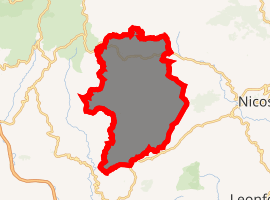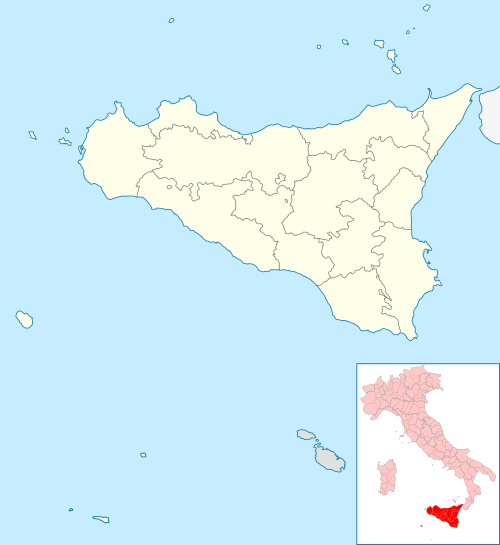Gangi, Sicily
Gangi[3] is a comune (municipality) in the Metropolitan City of Palermo in the Italian region Sicily, located about 80 kilometres (50 mi) southeast of Palermo.
Gangi | |
|---|---|
| Comune di Gangi | |
 | |
Location of Gangi 
| |
 Gangi Location of Gangi in Italy  Gangi Gangi (Sicily) | |
| Coordinates: 37°48′N 14°12′E | |
| Country | Italy |
| Region | Sicily |
| Metropolitan city | Palermo (PA) |
| Government | |
| • Mayor | Giuseppe Ferrarello |
| Area | |
| • Total | 127.1 km2 (49.1 sq mi) |
| Elevation | 1,011 m (3,317 ft) |
| Population (31 August 2017)[2] | |
| • Total | 6,568 |
| • Density | 52/km2 (130/sq mi) |
| Demonym(s) | Gangitani |
| Time zone | UTC+1 (CET) |
| • Summer (DST) | UTC+2 (CEST) |
| Postal code | 90024 |
| Dialing code | 0921 |
| Patron saint | St. Catald Bishop |
| Saint day | May 10 |
| Website | Official website |
Gangi borders the following municipalities: Alimena, Blufi, Bompietro, Calascibetta, Enna, Geraci Siculo, Nicosia, Petralia Soprana, Sperlinga. The town straddles the Madonie mountains of central Sicily.
History
Gangi's origins have been connected to the ancient Greek city of Engyon, or Herbita, but this theory remains unconfirmed. Traces of Roman presence are instead testified by archaeological excavations under the Abbey of Gangivecchio ("Old Gangi"). (But according to Glenn Storey, Francesca Spatafora and other archeologists and a consolidated historiography, Engio was near Gangi (today c.da Alburchia or c.da Gangivecchio,in Gangi's territory).
The current settlement dates to 1300, when it was rebuilt on the Monte Marone after its destruction in the course of the Sicilian Vespers war, as part of the county of Geraci. In 1625 it was acquired by the Graffeo family who, four years later, were made Princes of Gangi; in 1677 the title went to the Valguarnera. In the 18th century Gangi was a flourishing cultural centre, with several literary clubs and the construction of notable noble residences.
Later, after the unification of Italy, Gangi was the centre of fierce suppression of brigands who lived in the area. In 1926 it was the location of one of the hardest repression of the Mafia in Italy, carried out by the local prefect Cesare Mori.
In 2014, the local administration under a dynamic mayor began disposing of abandoned houses with some being given away and others being sold for a nominal price. The recipients had to agree to spend at least 35,000 euros on restoration within five years.[4] The giveaway is a means to stimulate tourism-related activities and diversify the local economy, which was primarily dependent on agriculture and animal husbandry.[5] The scheme has proved a great success.
Gangi is also a common Sicilian last name.
Main sights
- The castle, on the highest part of Mount Marone, built probably in the 14th century. It was the seat of the county lords.
- Palazzo Sgadari and Palazzo Bongiorno, two notable noble residences
- Mother church of San Nicolò di Bari (14th century). Today it is connected to the large Ventimiglia tower, which has been turned into a campanile. It houses a Final Judgement by Giuseppe Salerno, several statues by the local sculptor Filippo Quattrocchi, 18th-century frescoes in the SS. Sacrament oratory and a crypt with mummies of priests.
- Sanctuary of the Spirito Santo
- Abbey of Gangivecchio (1366)
- The notable Romanesque church of San Giuseppe dei Ricchi (also known as San Paolo)
- Late Baroque Chiesa della Badia
- Parish church of Santa Maria del Gesù, with a Romanesque campanile. It houses the precious sculptures of Madonna with Child and Annunciation by Quattrocchi.
Gallery
 Civic Tower of Ventimiglia Tower
Civic Tower of Ventimiglia Tower- Piazza del Popolo and Town Hall
- Church of San Paolo
- The lower town, with the church of SS. Salvatore
References
- "Superficie di Comuni Province e Regioni italiane al 9 ottobre 2011". Istat. Retrieved 16 March 2019.
- All demographics and other statistics: Italian statistical institute Istat.
- Mario Siragusa, Cenni storici su Gangi, Gangi-Roma, Archeoclub d'Italia, 2017
- http://www.comune.gangi.pa.it/sportellodoc/free_houses.pdf
- Povoledo, Elisabetta (22 June 2015). "Sicilian Town Tells Outsiders: Take Our Homes. Please". Retrieved 20 January 2019 – via NYTimes.com.
External links
- Official website
- http://www.gangivecchio.org/home
- Mario Siragusa, "La storia di Gangi", Bompietro-Locati, 2017: ; wiew: http://www.comitatoenginomadonita.altervista.org/CREM/